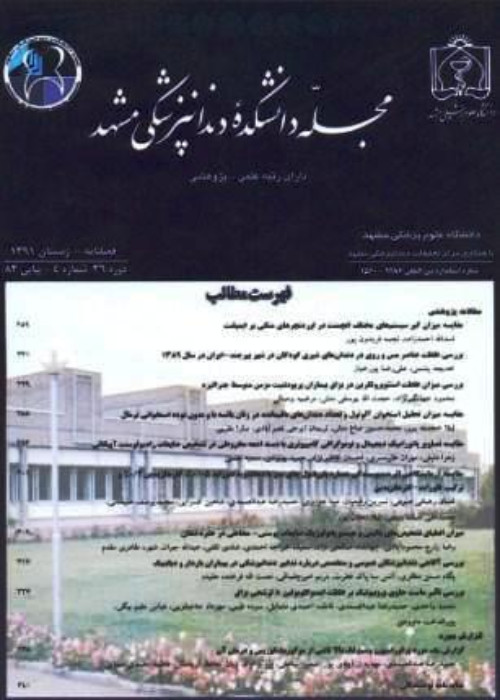Evaluation of the Antimicrobial Activity of Chlorhexidine and Eugenol on Planktonic and Biofilm-producing Viridans Group Streptococci Isolated from Dental Plaques
Author(s):
Article Type:
Research/Original Article (دارای رتبه معتبر)
Abstract:
Introduction
Viridnas streptococciare among the factors involved in dental caries and the subsequent diseases due to their ability in biofilm formation and the synthesis of extracellular polymers. Considering the difference in the resistance of biofilm forms and plankton pathogenic bacteria to bactericide agents, we aimed to compare the effect of chlorhexidine mouthwash and eugenol on planktonic and biofilm forms of viridnas streptococcito find the effective concentrations of the two products.Materials And Methods
Viridans streptococci were isolated from 20 human dental plaque samples using biochemical tests. The strain with the highest biofilm formation activity was identified more precisely using 16SrRNA gene analysis. The effects of chlorhexidine (0.06-0.2 w/v%) and eugenol (29.7-99 w/v%) were assessed on the planktonic and biofilm cells of the isolated viridans streptococciusing macrodilution broth and polystyrene microplates, respectively. In addition, the minimum inhibitory concentration (MIC) of these antiseptics on the isolated viridans streptococci was determined.Results
Strain UTMC 2446 with 98.04% similarity to Streptococcus sanguinis had the highest biofilm production ability. The 0.2% and 99% concentrations of chlorhexidine and eugenol inhibited biofilm formation, respectively, while these compounds could effectively inhibit planktonic cell growth at the 0.14% and 79.2% concentrations, respectively.Conclusion
For the tested compounds, the effective concentrations needed to inhibit biofilm formation were higher than those required for planktonic growth arrest. Moreover, due the possibility of emergence of resistant strains, as well as the fact that the required concentration is equal to the maximum concentration of the compounds in commercial products, their antimicrobial potential must be regularly monitored. Our findings can be beneficial for manufacturing and quality control facilities. Keywords:
Language:
Persian
Published:
Journal of Mashhad Dental School, Volume:42 Issue: 1, 2018
Pages:
75 to 86
magiran.com/p1803548
دانلود و مطالعه متن این مقاله با یکی از روشهای زیر امکان پذیر است:
اشتراک شخصی
با عضویت و پرداخت آنلاین حق اشتراک یکساله به مبلغ 1,390,000ريال میتوانید 70 عنوان مطلب دانلود کنید!
اشتراک سازمانی
به کتابخانه دانشگاه یا محل کار خود پیشنهاد کنید تا اشتراک سازمانی این پایگاه را برای دسترسی نامحدود همه کاربران به متن مطالب تهیه نمایند!
توجه!
- حق عضویت دریافتی صرف حمایت از نشریات عضو و نگهداری، تکمیل و توسعه مگیران میشود.
- پرداخت حق اشتراک و دانلود مقالات اجازه بازنشر آن در سایر رسانههای چاپی و دیجیتال را به کاربر نمیدهد.
دسترسی سراسری کاربران دانشگاه پیام نور!
اعضای هیئت علمی و دانشجویان دانشگاه پیام نور در سراسر کشور، در صورت ثبت نام با ایمیل دانشگاهی، تا پایان فروردین ماه 1403 به مقالات سایت دسترسی خواهند داشت!
In order to view content subscription is required
Personal subscription
Subscribe magiran.com for 70 € euros via PayPal and download 70 articles during a year.
Organization subscription
Please contact us to subscribe your university or library for unlimited access!


